http://aceliverpoolescorts.co.uk/6md4m/saiba.auction Recently Voynich Views posted a blog about the line (or lack of one) connecting the fish that represent the astrological symbol Pisces, paying specific attention to those that look like the VMS long-nosed fish. I have a dataset of more than 500 zodiac cycles, so I thought I would post them to help round out the picture.
Long-nosed fish are definitely in the minority. Only about 8% of the total samples in my files have long noses, and if you filter out those with a line between the fish, only 3% remain.
The majority of those with long noses originated in France, with a few from Austria and Germany. There were also single examples from Italy, Spain, Belgium, and the Netherlands. If you look back at the map of symbols similar to VMS Scorpio, you will see that several of those that resemble the VMS lizardy Scorpius are also from France.
The earliest examples, mainly from the 12th and 13th centuries are from France, England, Cologne, and Austria. Those enclosed in circles are from France, Austria, Germany, and the Hague.
Only two or three of the fish pairs have the same “wavy” shape as the VMS fish (a couple from Paris, possibly one from England, and one from Austria). Note that the 12th century zodiac from Seckau, Austria, may have had the drawings added in the 15th century, so I have sorted according to the later date [click to see larger]:
It’s interesting that so many of the VMS details are in the minority. Crossbow Sagittarius is relatively uncommon, as is lizardy Scorpius, and double-Cancer. The Gemini “courting couple” is also uncommon.
Pisces with a long nose is quite uncommon, especially those without a line between the fish. I sometimes wonder if the person who designed the VMS zodiac signs got the general idea from looking at zodiacs but inserted pictures copied from other sources. For example, in CLM 10072 and BNF Lat. 13025, we see a long-nosed fish in a pond, and a long-nosed fish with the scales emphasized in an embellished initial. The Book of Wonders and the Rochester Bestiary also have a variety of long-nosed fish. Plus, there are a couple of “zodiac man” images with long-nosed fish under the man’s feet that I didn’t include in the above compilation.
Another way that the VMS fish differ from many fish drawings is the way the scales cover the whole body. Many illustrators don’t put scales on the bellies:
The wavy form of the VMS bodies is also unusual. I found a “wavy” fish in an Arabic manuscript, but other than the undulating posture, it doesn’t strongly resemble the VMS fish. It has spots, three fins top and bottom, a pale belly, and a drawing style that is much more eastern:
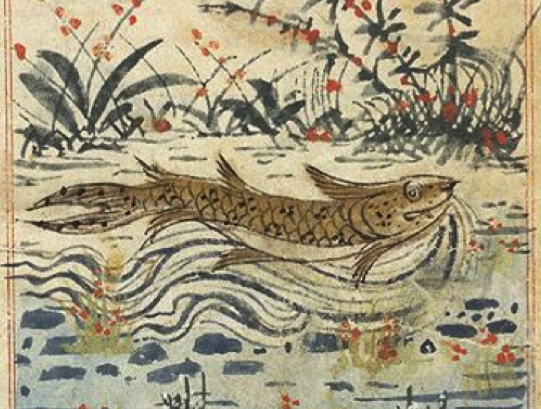 There are also some long-nosed fish in the marketplace and in the water in Tacuinum Sanitatus:
There are also some long-nosed fish in the marketplace and in the water in Tacuinum Sanitatus:
This fish is scaly top to bottom, but the fins and nose are quite different from the VMS fish:
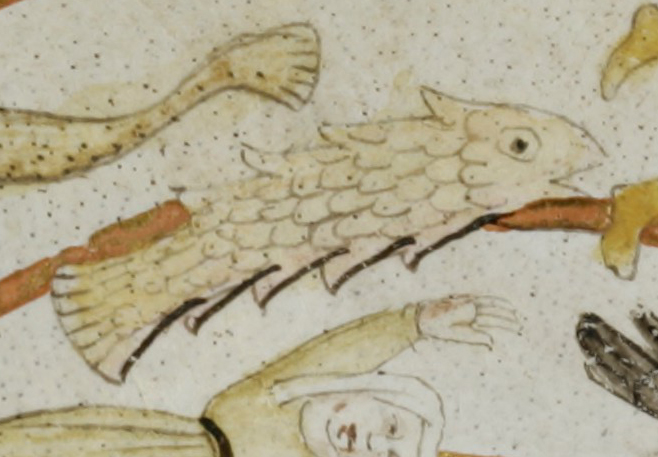 In the planetary influences section, Cod. Sang. 760 has a human Sagittarius and some scaly long-nosed fish, but the fish are roughly sketched and probably later than the VMS:
In the planetary influences section, Cod. Sang. 760 has a human Sagittarius and some scaly long-nosed fish, but the fish are roughly sketched and probably later than the VMS:
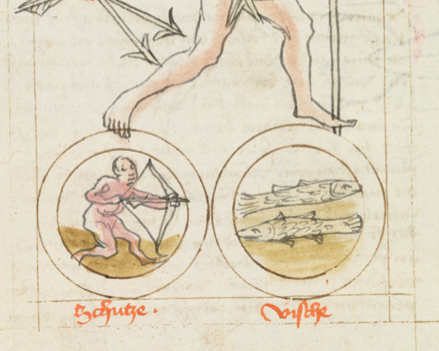 Morgan B.19 has a very cute drawing that looks like it was done by a child that includes a long-nosed fish with double dorsel fins:
Morgan B.19 has a very cute drawing that looks like it was done by a child that includes a long-nosed fish with double dorsel fins:
In the Andalius De Sphaera (c. 1327), we see long-nosed dolphins. They’re not fish, they’re mammals but many old texts refer to them as fish and even today many people call them “fish”:
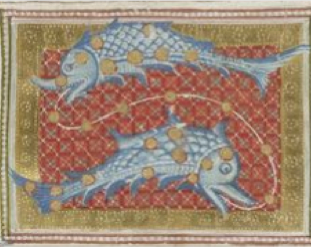 Family emblems, such as this one (which also features cloud-band imagery), sometimes include long-nosed fish:
Family emblems, such as this one (which also features cloud-band imagery), sometimes include long-nosed fish:
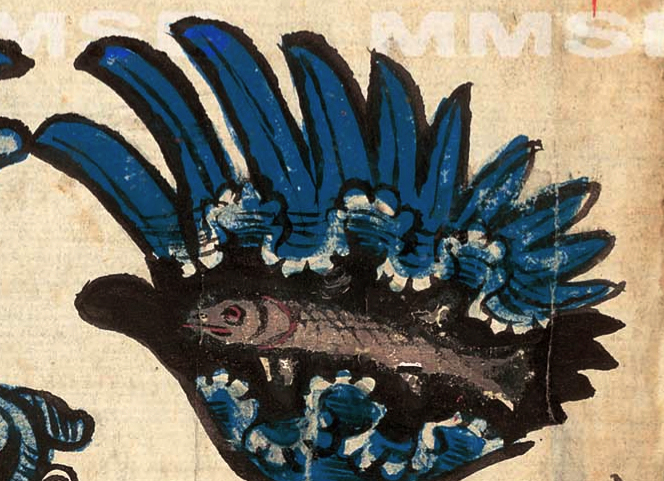 The best match I’ve seen for the VMS fish outside of zodiac imagery was the one pointed out by MarcoP in the Sachsenspiegel. It has a long nose, a face quite similar to the VMS fish, and is scaly top to bottom. I’ve turned it sideways so it is easier to see:
The best match I’ve seen for the VMS fish outside of zodiac imagery was the one pointed out by MarcoP in the Sachsenspiegel. It has a long nose, a face quite similar to the VMS fish, and is scaly top to bottom. I’ve turned it sideways so it is easier to see:
Summary
Even though the VMS long-nosed fish are unique in a number of ways, there are several possible sources for the imagery, including zodiacs, bestiaries, and manuscripts unrelated to astrology.
The Parisian zodiac dating from c. 1350 (Morgan M.75) is the closest I’ve found so far as a Pisces symbol, in terms of style and features. Morgan M.75 also includes a four-legged Scorpius and crayfish Cancer, so perhaps there is some common source that connects them, but I’d like to gather more information and continue analyzing what I have before venturing any conclusions.
J.K. Petersen
[Postscript July 27, 2018] I found this picture after I posted the blog:
The drawing style is different from the VMS, but the features are notable. It has long-nosed double-dorsal fish that are scaly from top to bottom. Plus, something that is even harder to find in fish with these characteristics… the lower one has an undulating posture. The image detail is from a 14th-century hell-mouth fresco in the Timios Prodromos monastery in Serres, Greece.
Serres also has grottoes with fabulous stalactites. I’m always on the lookout for grottoes since some of the VMS bathing images have grotto-like structures.
J.K. Petersen
Postscript 30 August 2018: It has been suggested that the VMS Pisces symbol represents the New World alligator gar. Here is a picture of the gar. Note there is one fin top, two sets of fins bottom-front, and another fin back-bottom. Drawn from the side, it might look like one top and three bottom.
 If the researchers who identified the VMS fish as alligator gar are going to ignore the mismatch in the number of fins, then any fish with a long nose could be said to be similar to the VMS fish, including the northern pike, which is indigenous to both Old and New Worlds:
If the researchers who identified the VMS fish as alligator gar are going to ignore the mismatch in the number of fins, then any fish with a long nose could be said to be similar to the VMS fish, including the northern pike, which is indigenous to both Old and New Worlds:
 The same researchers claim the fish with the nymph in its mouth on folio 79v is also an alligator gar. I can’t take that seriously. Look at the mouth, it’s very broad and blunt, more like a wide-mouthed bass:
The same researchers claim the fish with the nymph in its mouth on folio 79v is also an alligator gar. I can’t take that seriously. Look at the mouth, it’s very broad and blunt, more like a wide-mouthed bass:
In contrast, the mouth of the alligator gar is long, narrow, and toothy (especially this species):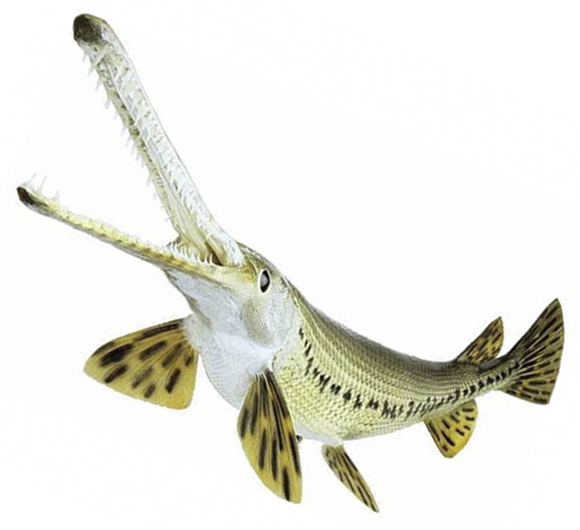
Natural or Traditional?
Four years ago, I looked at hundreds of pictures of New World and Old World fish and there are several with long noses and two fins top and two bottom, but I have the feeling the VMS illustrator consulted other drawings rather than studying real fish because VMS Pisces resembles medieval illustrations more than it does naturalistic drawings of the time.
Here is a small subset of Pisces symbols with varying numbers of fins and long noses. They are all Old World illustrations:
I’ll leave it to the reader to decide whether the VMS fish look more like the New World alligator gar, or like fish in pre-conquest medieval illustrations. I’m partial to the fish in the Sachsenspiegel with its similar face and tail, and to the fish in the Greek fresco, which have the right number of fins, top-to-bottom scales, and narrow curvy bodies.
© Copyright 2018 J.K. Petersen, All Rights Reserved

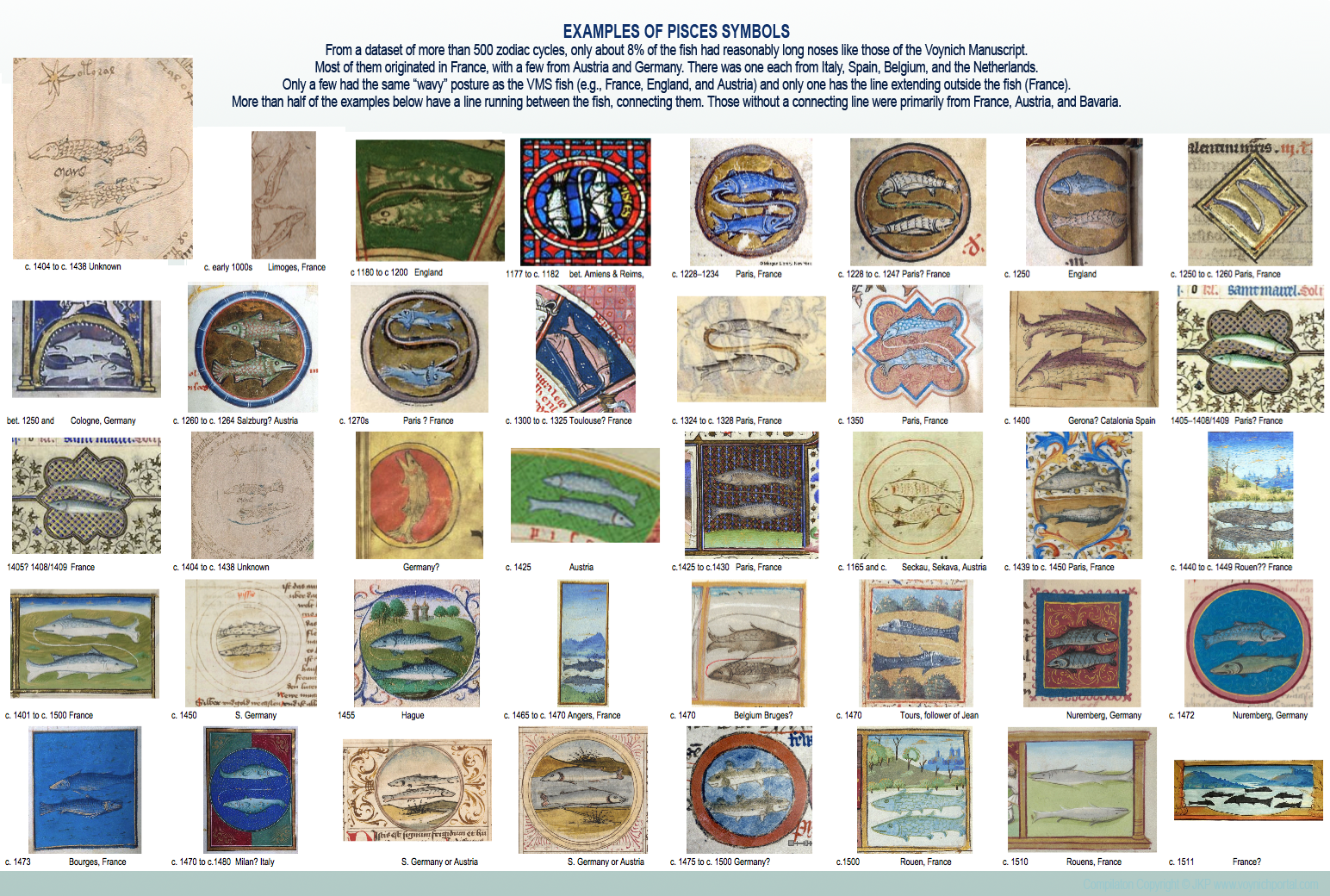
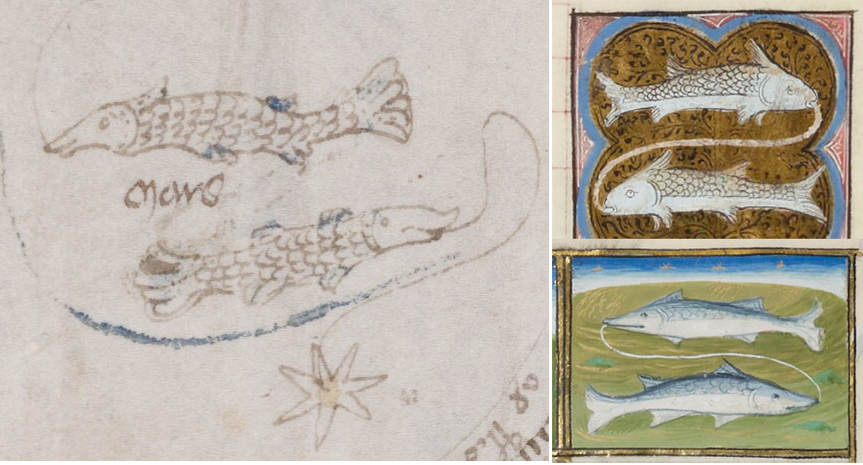
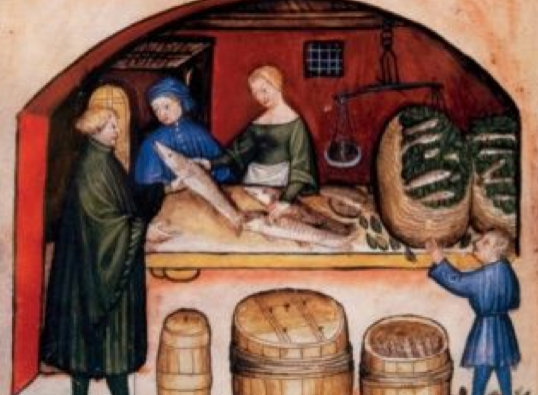
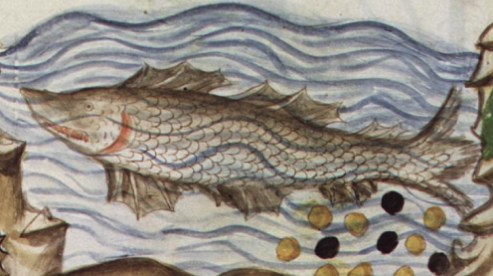

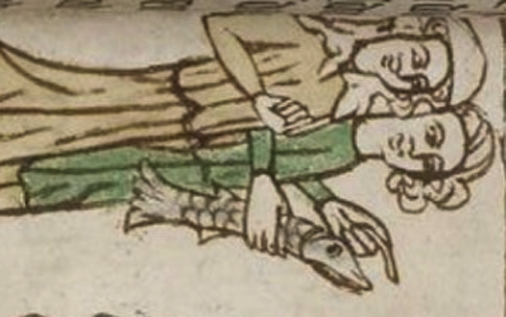
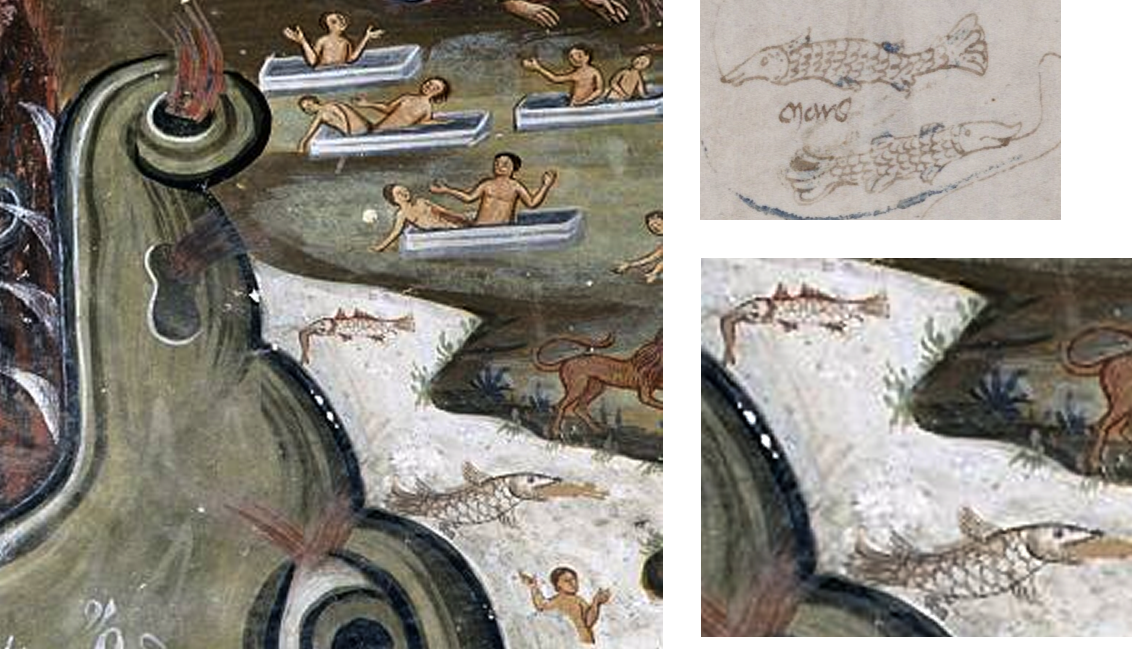
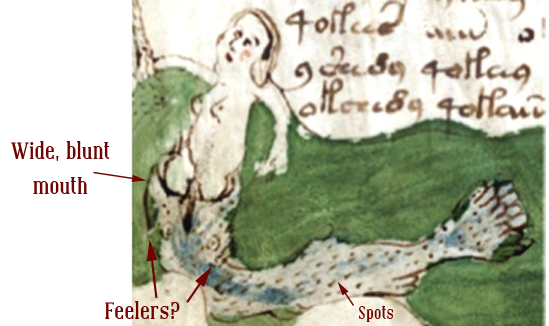
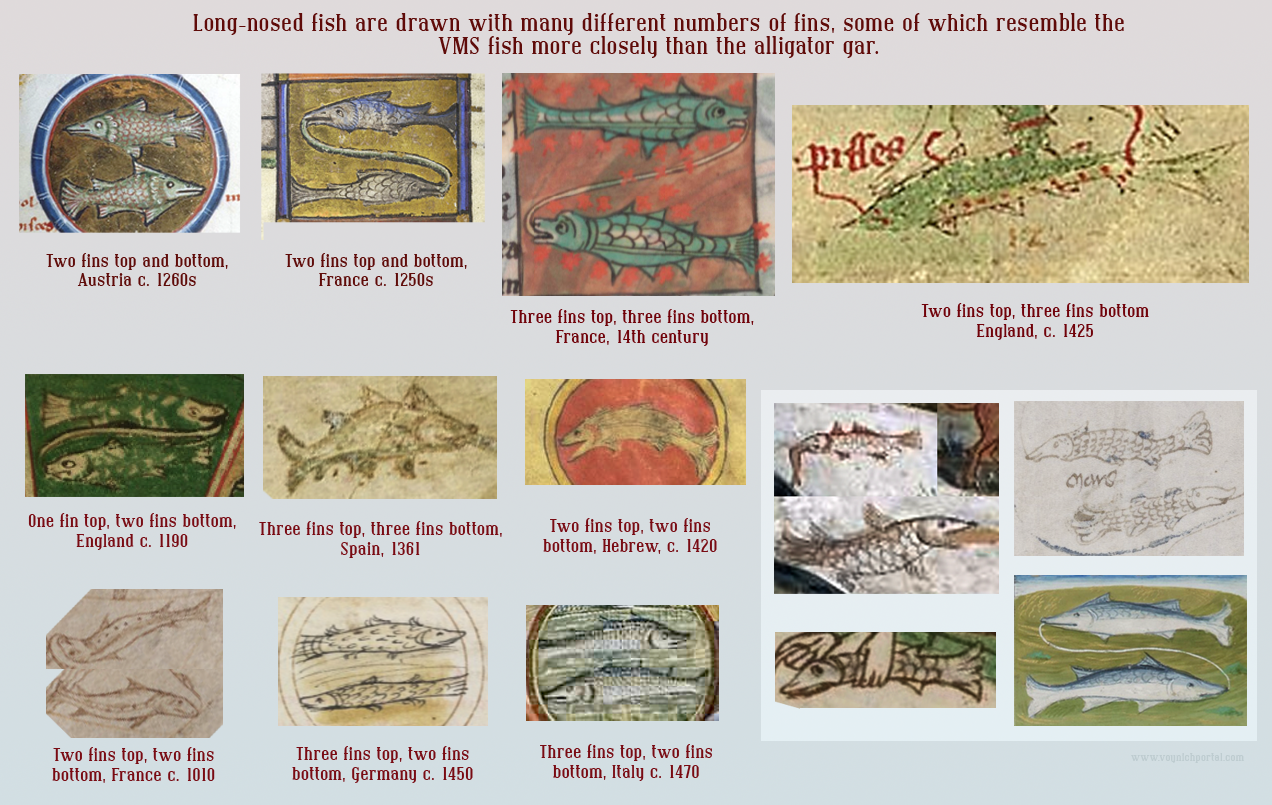
Hi JKP,
The criteria in my post are: No line connecting the fish, long snouts, head to tail, scales. All of these must be present to match the Voynich. It’s not either/or.
As I mentioned in my post, it turns out that these criteria are extremely local to Germany/Austria/Switzerland, especially if you are looking for ones in a roundel.
Although you don’t say it in this post, and your collection isn’t restricted to mathing all these criteria, it was interesting to see that those that actually do match are also all from the German/Austrian area.
I wish you would provide the references for your examples in the composite. Which MS is the “1260 Salzburg”?
Yes we were looking for fish from different points of view, your criteria were different from mine. But since we have information on a related topic, I thought it might be a good time to post what I have.
I have not investigated the blue paint at all (except in reference to some of the plants), so I can’t comment on that. Readers are encouraged to reference your blog as it looks like a topic worth discussing.
My blogs are always on the long side and adding another 40 references really bogs it down (and sometimes gives away something I’m still investigating), but the c. 1262 Austrian zodiac (possibly from Salzburg, which I think was transferred further east to Seitenstetten) is Nampula Morgan Ms M.855. When you see it, you might recognize the “turtle” Scorpius as similar to the one by Hildegard von Bingen. Also, Cancer is a crayfish. Unlike the VMS, however, Sagittarius is a centaur with a longbow.
Edit [addition]: I forgot to mention, I think the one from Toulouse is especially interesting as it has a longer nose than most and the line goes uncharacteristically under the bottom fish.
Another potential criterion is whether the fish have a tail that has a singular, fan-shape (VMs) or if the tail is bifurcated into upper and lower lobes. I see both in your examples.